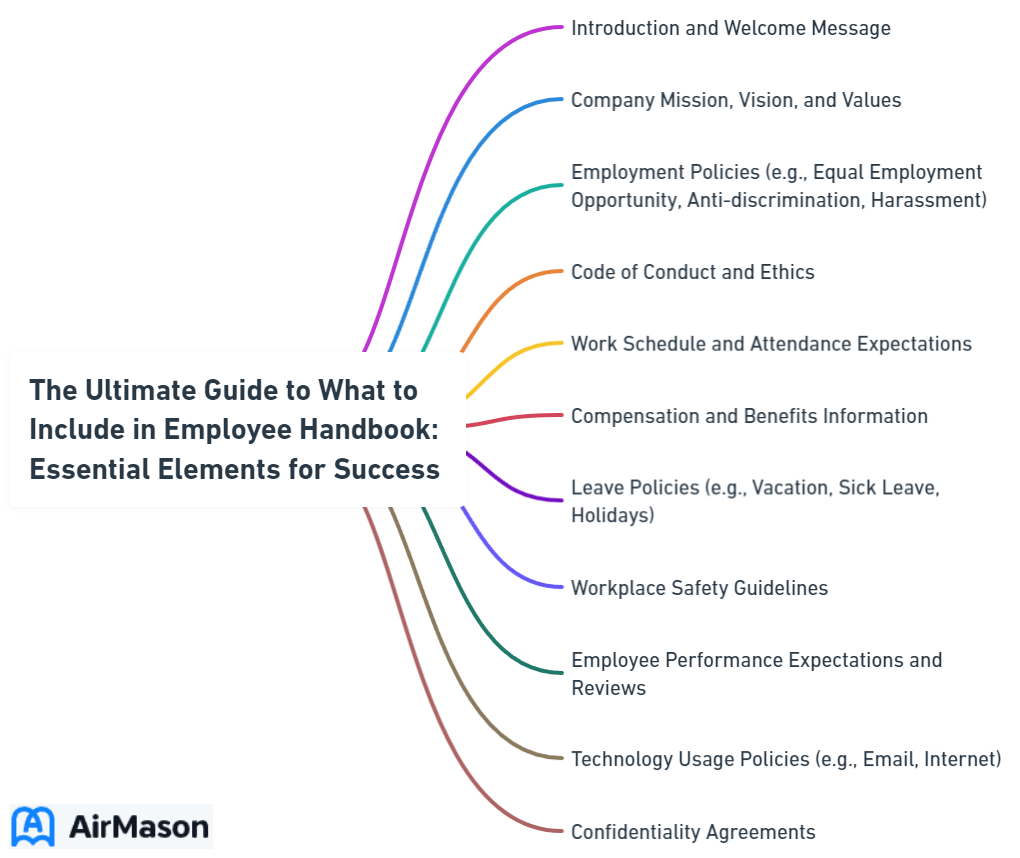
Are you wondering what to include in employee handbook? This practical guide strips away the fluff, diving straight into the components you need: core policies, company values, compliance guidelines, and benefits details. Get ready to construct an employee handbook that communicates clearly with your team and stands the test of legal scrutiny.
Key Takeaways
- An employee handbook is a vital document that outlines a company’s culture, expectations, and policies, serving not only as an introduction for new hires but also as a legal safeguard for the company.
- Key policies such as attendance, anti-harassment, non-discrimination, and conduct guidelines create a framework for employee behavior and responsibilities, ensuring a respectful and productive work environment.
- Regular updates to the employee handbook are crucial to maintain relevance and legal compliance, and effective distribution ensures that all employees have access to the most current company policies and procedures.
Understanding the Employee Handbook

An employee handbook is more than just a document – it’s the bridge between the company and its employees, communicating the company’s expectations, outlining employee benefits, and painting a clear picture of the consequences of non-compliance, all while providing a sense of company culture. This handbook is an invaluable resource for new hires, helping them understand the company’s culture, and acting as a shield, protecting the company from potential legal disputes.
However, creating an employee handbook isn’t just about compiling a list of rules. It’s about crafting a well-structured, simple, and accessible document that avoids confusing wording and ideally undergoes a legal review for compliance. The tone of the handbook also matters – maintaining a positive and professional tone sets clear expectations while promoting a productive work environment.
All employees should acknowledge that they have read and understood the policies by signing and dating a receipt, which protects the company in future incidents. Regular review and updates ensure the handbook remains current and relevant.
Building a Solid Foundation: Company Culture, Values, and Mission
An employee handbook is like the blueprint of a building, outlining the company’s:
- culture
- values
- mission
- goals
It sets the framework for the company’s structure and is where the company’s mission, vision, and values are etched. It reinforces company values, aligns employees with the organization’s direction, and nurtures a sense of belonging and shared purpose.
Incorporating the company’s origin story in the handbook can resonate with employees, inspiring them to internalize the company’s foundational vision. To make these values more relatable and actionable, the handbook can include real-life examples, employee stories, and visual aids. This way, company values aren’t just words on paper, but habits that contribute to a vibrant company culture.

Key Employment Policies and Procedures
Let’s dive into the heart of the employee handbook – the key employment policies and procedures, which are in compliance with employment laws. These are the rules of the game, guiding employee behavior, and defining how the company operates.
A well-defined employee handbook should include the following policies:
- Attendance policy
- Code of conduct
- Anti-harassment policy
- Non-discrimination policy
These policies are fundamental to fostering an inclusive, respectful, and productive work environment. To ensure that all employees are on board, signed acknowledgments from employees should be obtained to verify that they have received, reviewed, and understood the handbook.
Workplace Conduct and Behavior

The company policy on workplace conduct is the company’s compass, guiding employees on how to navigate their work life. It encompasses guidelines on:
- Legal compliance
- Ethical behavior
- Respect in the workplace
- Prevention of discrimination or harassment
It also sets the ground rules for the protection and proper use of company property, both physical and intellectual.
The conduct policy also outlines how conflicts of interest should be avoided, and encourages collaboration, and open communication between all levels of staff. Managers play a vital role in this process, setting clear objectives, providing feedback, recognizing team member motivations, and aspirations, and maintaining logs of significant incidents.
Violations of conduct can be met with disciplinary actions, ranging from a reprimand to termination, ensuring that the work environment remains harmonious and productive.
Anti-Harassment and Non-Discrimination

The own employee handbook, which often includes the employment agreement, is a sanctuary, asserting the company’s stance as an equal opportunity employer with a clear commitment to non-discrimination in all aspects of employment. It’s the shield that ensures a workplace free from harassment, fostering an environment of respect and inclusivity. In compliance with the Fair Labor Standards Act, an employment attorney can help ensure that these policies are legally sound and effectively implemented.
Clear guidelines on how affected employees can report harassment, detailing appropriate contacts, and describing subsequent company actions, are crucial components of this shield. The consequences of harassment are not just a slap on the wrist – clear disciplinary actions, including termination, are stipulated for employees who are found to have engaged in harassment.
Attendance and Punctuality
Time is money, and in the workplace, efficient time management is crucial. This is where the attendance policy comes in, shaping clear expectations about employee time management. It’s a guiding star, defining:
- work hours
- break times
- work-from-home arrangements
- punctuality expectations
The policy also outlines the consequences of tardiness, early departure, and unreported absences, holding employees accountable for their attendance. By complementing the attendance policy with provisions for different leave types such as bereavement, sick leave, and legally mandated leaves, the company ensures that employees are well-supported in their professional journey.
Compensation and Benefits Overview

Every employee has their eye on the prize – their compensation and benefits. The employee handbook, sometimes referred to as an employee manual, lays it all out, detailing:
- Payroll schedules
- Paycheck deductions
- Job classifications
- Salary
- Bonuses Additionally, the employee’s personnel file contains important documentation related to their employment history.
It also throws light on the various company programs benefits employees can avail, like paid holidays, sick leave, overtime compensation, timekeeping, and paid vacation.
Salary and Wages
In the game of work, salary and wages are the score. The employee handbook ensures transparency, specifying minimum pay levels and outlining the factors that determine individual pay rates, such as experience, education, budget, market rate, and internal equity.
The handbook also explains the policy for overtime pay and the actions that may lead to changes in an employee’s rate of pay, including:
- Annual pay adjustments
- Promotions
- Demotions
- Reorganizations
- Reclassifications
- Market pay increases
- Lateral transfers
- Interim appointments
Such clarity ensures that there are no surprises when it comes to employees’ paychecks.
Employee Benefits
Employee benefits are the cherries on top of the cake of compensation. The handbook outlines various health and welfare benefits such as:
- Health insurance
- Disability insurance
- Life insurance
- Retirement plans
- Paid time off
- Other leave policies
The eligibility criteria for each benefit, including those under the Disabilities Act, are clearly explained, detailing waiting periods and the enrollment process. And while these benefits are there for employees to utilize, the handbook also emphasizes the importance of responsible usage, discouraging abuse of benefits like time off and insurance.
Performance Management and Reviews
The employee handbook doesn’t just state the rules of the game, it also explains how the game is scored. The handbook explains the performance management system, including how performance is measured and reviewed.
Performance reviews are like the halftime discussions in a game, providing feedback, discussing career opportunities, areas for improvement, and setting development plans. The handbook also provides guidelines for rewards, training opportunities, and emphasizes the importance of frequent communication between managers and employees for continuous feedback.
Workplace Guidelines and Expectations

The employee handbook also lays the groundwork for a professional work environment, setting guidelines for dress code, communication best practices, and electronic device usage. This ensures a consistent and respectful workplace atmosphere, where employees understand what is expected of them.
Dress Code and Appearance
Let’s face it – appearances matter, especially in a professional setting. The handbook outlines the dress code policy, promoting a positive and professional image of the company. Categories such as:
- Business formal
- Business professional
- Business casual
- Casual
Each with its own set of expectations, are clearly defined.
But it’s not just about what to wear, it’s also about what not to wear. The handbook lists attire usually deemed inappropriate for a professional setting, ensuring that all employees are on the same page when it comes to wardrobe expectations.
Communication Best Practices
Communication is the lifeline of any organization. The handbook establishes clear guidelines for the use of various channels such as email and social media within the company. It details:
- The goals
- Chosen communication methods
- Necessary tools and applications
- Preferred message style and content
- Roles and responsibilities
Effective communication is not just about sending messages, it’s also about managing the frequency and style of these messages. The handbook emphasizes the importance of consistent timing, style, and tone, and discourages inundating employees with excessive messages.
Electronic Device Usage
In the digital age, managing electronic device usage is crucial. The handbook sets policies for the responsible use of company-owned and personal devices in the workplace. These include guidelines for the maintenance and security of company-owned devices like laptops and smartphones.
The policy also details what is allowed and not allowed with company devices, including personal activities. For personal devices, the handbook outlines restrictions during work hours and acceptable use during breaks. Violations of these policies can result in disciplinary measures, ensuring that the work environment remains focused and productive.
Onboarding and Offboarding Processes
The employee handbook plays a crucial role in welcoming new recruits aboard the company ship and waving them off when they disembark. It’s integrated into the onboarding process for new hires, acting as a reference point for decisions during employment.
The onboarding process introduces new employees to the company’s workspace, policies, and culture. On the other hand, the offboarding process involves formal termination of employment, such as timing of the final paycheck, return of company assets, and the management of COBRA benefits. Both these processes are designed to be respectful and leave a positive impression, turning employees into brand advocates and potentially opening the door for them to rejoin the company in the future.
Legal Compliance and Employee Rights
An employee handbook serves multiple purposes:
- It is a guide for employees, providing them with information about company policies, procedures, and expectations.
- It is a tool for managers and supervisors, helping them enforce policies consistently and fairly.
- It is a shield for the company, as it is regularly updated to reflect changes in labor laws and regulations, maintaining legal compliance and protecting the company from potential legal issues.
Including information about employee rights in the handbook helps protect employers legally, making staff members aware of their rights, such as those pertaining to a safe and discrimination-free environment. Disclaimers in the handbook limit disputes and acknowledge employee comprehension and compliance, ensuring that the company has a legal record and the employees are informed of their rights and responsibilities.
Updating and Distributing the Employee Handbook
An employee handbook is not a one-time creation – it’s a living document that evolves with the company. Employee handbooks should be updated regularly to reflect changes in policies and legal requirements. When revising the handbook, it should be made clear that new versions supersede previous ones, with older versions kept for reference.
Distributing the handbook is just as important as creating it. It can be done in electronic or hard copy form, using online platforms or intranet services for easier updates and increased accessibility. Any updates to the handbook should be communicated promptly to employees, ensuring they are always up-to-date with the latest policies and procedures.
Summary
We’ve journeyed through the various components of an employee handbook, exploring its purpose, content, and the crucial role it plays in maintaining a productive, respectful, and compliant work environment. From introducing company culture to setting expectations and guidelines, from detailing compensation and benefits to outlining onboarding and offboarding processes, the employee handbook is indeed the lifeblood of an organization. It’s a testament to the fact that clarity, transparency, and communication are the pillars of a successful workplace.
Frequently Asked Questions
How to write employee handbook?
When writing an employee handbook, make sure to include key sections such as Introduction & Welcome, Workplace commitments, Company Policies and Procedures, Employment Classification, Attendance Policies, Leave Policies, Work Performance, and Discipline Policy. It’s also important to understand the company’s history and values, include necessary policies, avoid unnecessary ones, and gather feedback for an effective handbook.
Which of the following is included in the employee handbook?
The employee handbook includes company behavior policies such as a no smoking policy, a dress code, an attendance policy, a use of company property policy, and a no substance abuse policy. These policies clearly describe employee expectations.
Which sections in the employee handbook would be most useful?
The most useful sections in the employee handbook would include topics such as at-will relationship, equal employment opportunity, conduct, compensation and performance, benefits and leaves, health and safety, workplace guidelines, and acknowledgment of receipt for employees to sign.
What would not be included in an employee handbook?
Non-competes, non-disclosure agreements (NDAs), or any policy that might change the at-will employment relationship should not be included in an employee handbook. It’s important to include a disclaimer in the handbook.
What is the purpose of an employee handbook?
The purpose of an employee handbook is to introduce company culture, communicate management’s expectations, outline employee benefits, describe consequences of non-compliance, and act as a reference for employees. It helps employees understand company policies and their rights.
Disclaimer:
Please be aware that the content on this page has been generated by using artificial intelligence language models and may contain errors, inconsistencies, or outdated information.
It is provided as-is without any warranties or guarantees of accuracy. We strongly recommend using this content as a starting point for further research. We disclaim any liability for damages or losses resulting from the use or reliance on this content.